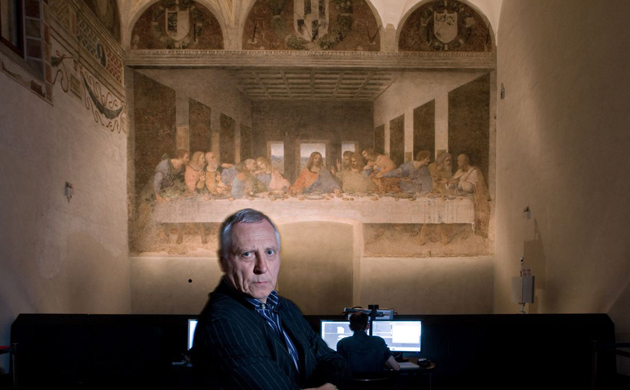Peter Greenaway's Last Supper

With a glint of a dagger and a blaze of celestial light, Leonardo da Vinci's The Last Supper burst into new life on Monday night after Peter Greenaway finally secured permission to reinvent the crumbling, 510-year-old masterpiece as a sound and light show.
In a remarkable coup for the British film director, the Italian authorities allowed Greenaway to wheel a battery of projectors, computers and speakers into the usually hushed and air-sealed refectory of Santa Maria delle Grazie, where the image of Christ telling the apostles one of them will betray him decorates an end wall. Inside, Greenaway unveiled a provocative vision of one of Christianity's most sacred and fragile paintings, reimagined "for the laptop generation".
To the strains of modern opera, he used cutting-edge technical trickery to make Leonardo's Christ appear like a three-dimensional hologram while a radiant sun rose and fell over his head. He turned the original colourful image red, grey and black before the artist's gentle brush strokes were replaced with a chalk outline of the 13 figures, as if Leonardo had drawn a crime scene. Dawn broke, dusk fell and by the end the disciples had been dramatically cast into the shadow of prison-like bars.
To at least one of the world's experts on Da Vinci, Greenaway's work amounted to cultural vandalism. But to others it may have saved The Last Supper's reputation from The Da Vinci Code, Dan Brown's blockbuster novel, which frustrated many experts by reducing the painting's hidden meanings to a plot device.
"It has reconsecrated the painting after Dan Brown deconsecrated it," said Vittorio Sgarbi, a leading art critic and former head of arts for the Milan local government.
Monday's one-off performance almost did not happen. For 18 months there was such controversy over possible damage to the painting and fears that Greenaway would blaspheme that the authorities refused permission. Pietro Marani, one of the world's leading Leonardo scholars who spent 17 years on the painting's latest restoration, said he would not attend. "I don't think it is appropriate to use the painting as a projection screen for a performance of contemporary art," he said. "We did not conserve this so that it would become an artist's material. Peter Greenaway uses Leonardo because it will grab the world's attention."
Permission was finally granted late last month by the national government in Rome. Greenaway was only allowed to stage the show for one night and to a select group of Milanese dignitaries, art experts and a few of the friary's monks.
But despite the small audience, there was a feeling that Greenaway's show could become a pivotal moment in the painting's history, briefly restoring what some say was lost from the original during the latest restoration.
"If Leonardo was alive now he wouldn't just be interested in film-making, he would be handling high-definition cameras and would be right up against the cutting edge experimenting with holograms," said Greenaway. "He would be fascinated by the post-digital age. I am sure that he would support entirely what we are doing, which isn't true of a series of academics who believe that this painting belongs to them and not to the world at large. This painting belongs to the laptop generation as much as it does to academia and we want to demonstrate that."
He was forced to drop plans to show the apostles' cups overflowing with blood and to project Christ's genitals on the refectory walls. But he said his goal was never to shock, but to help people look again at a work of art that has been devalued by superficial familiarity "on chocolate boxes and on T-shirts".
After the performance, the audience responded with enthusiasm.
"I saw things that I have never seen before," said Francesca Fiore, 41, a manager with Vodafone Italia. "I saw details and the backdrop which usually you don't notice at all - details that you tend not to see because you only focus on the main scene." "It was incredible," said Pierre Demarani, a publisher. "There is a new light, a new colour and a new vision. It is absolutely in line with the painting. It is a performance that adds value and shows the painting with another point of view."
Greenaway's production team said they are now keen to find an art gallery in Britain that could stage The Last Supper show on a full-size replica. Meanwhile, Greenaway plans to repeat the trick on Las Meninas by Velázquez, Picasso's Guernica, Monet's Waterlilies and a Jackson Pollock in New York.
His ultimate ambition is to take on Michelangelo's Last Judgment in the Sistine Chapel, and talks have begun with its gatekeepers at the Vatican.



Comentários